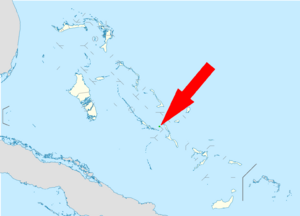White Cay iguana facts for kids
Quick facts for kids White Cay iguana |
|
|---|---|
 |
|
| Conservation status | |
| Scientific classification |
|
| Kingdom: | Animalia |
| Phylum: | Chordata |
| Class: | Reptilia |
| Order: | Squamata |
| Suborder: | Iguania |
| Family: | Iguanidae |
| Genus: | Cyclura |
| Species: | |
| Subspecies: |
C. r. cristata
|
| Trinomial name | |
| Cyclura rileyi cristata (Schmidt, 1920)
|
|
 |
|
The White Cay iguana (scientific name: Cyclura rileyi cristata), also known as the Sandy Cay rock iguana, is a very rare type of lizard. It is a subspecies of the Cyclura genus. This special iguana lives only on one small island called White Cay (or Sandy Cay) in the Southern Exumas, which are part of the Bahamas. It is considered a critically endangered animal, meaning it is at high risk of disappearing forever.
Contents
About the White Cay Iguana
The White Cay iguana is a type of lizard from the family Iguanidae. It was first studied in 1902 by Leonhard Hess Stejneger. Later, in 1920, an American scientist named Karl Patterson Schmidt gave it its specific subspecies name. In the Bahamas, these animals are simply called iguanas.
The scientific name rileyi comes from an American biologist named Joseph Harvey Riley.
What Does the White Cay Iguana Look Like?
The White Cay iguana is the smallest type of Cyclura iguana. When fully grown, it can be about 280 mm (11 in) long.
- Adults: Their backs are usually gray-brown or orange-brown. They have bright orange highlights on their back scales, front legs, and parts of their head and face.
- Young Iguanas: Baby iguanas do not have these bright colors. They are usually solid brown or gray with faint, slightly darker stripes.
Male iguanas are usually bigger than females. They also have taller crests (spiky ridges) along their backs. Males have special pores on their thighs that release chemicals called pheromones. Females do not have these pores and have shorter crests. This difference in appearance between males and females is called sexual dimorphism.
Where Do White Cay Iguanas Live?
These iguanas once lived on many large islands in the Bahamas. But today, they can only be found on one small island called White Cay, also known as Sandy Cay.
In 1997, scientists estimated that there were only about 150 to 200 White Cay iguanas left. This makes them very rare.
What Do White Cay Iguanas Eat?
Like all Cyclura iguanas, the White Cay iguana mainly eats plants. About 95% of their diet comes from eating leaves, flowers, and fruits from at least seven different plant types. Some of these plants include Seaside Rock Shrub (Rachicallis americana) and Erect Prickly Pear (Opuntia stricta). They very rarely eat insects.
Reproduction and Life Cycle
Female White Cay iguanas are ready to have babies when they are about 20 cm (7.9 in) long from their nose to the base of their tail and weigh about 300 g (11 oz). Males seem to become ready to reproduce when they are a bit larger, usually around seven years old.
Mating happens in May and June. The females usually lay 2 to 3 eggs in June or July. They dig nests in sunny spots in the ground to lay their eggs.
Protecting the White Cay Iguana
The White Cay iguana is one of the most endangered types of rock iguanas in the West Indies. It is listed as "critically endangered" by the IUCN Red List, which means it is in extreme danger of extinction. Some even say it might be the most endangered lizard on Earth.
Threats to the Iguanas
- Predators: In the past, imported black rats and a wild raccoon caused a lot of harm to the iguana population by eating them. The rats were removed from the island in 1999. The raccoon, which someone had let loose on the island, was also found and removed. This raccoon was responsible for killing many female iguanas while they were sleeping in their nesting burrows.
- Illegal Pet Trade: People illegally taking these iguanas to sell as pets has also hurt their numbers. For example, in 1994, pictures of these iguanas were seen in a magazine showing animals for sale by reptile dealers in Florida.
- Uneven Sex Ratio: The population might also be struggling because there are many more males than females. Out of the 200 remaining iguanas, about 90-95% are males. This makes it harder for the iguanas to reproduce and recover their numbers, especially since each female only lays 2-3 eggs per year. This could lead to a problem called a genetic bottleneck, where there isn't enough variety in their genes to keep the population healthy in the long run.
Conservation Efforts
As of 2007, there are no legal programs to breed these iguanas in captivity outside of the Bahamas. The Bahamian government does not allow these rock iguanas to be taken out of the country. Local people try to keep tourists away from the island to protect the iguanas. The island is also watched by planes from the United States Drug Enforcement Administration.


